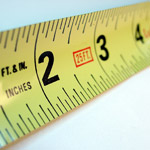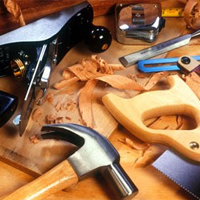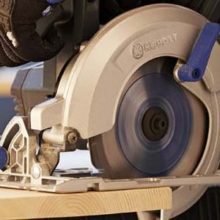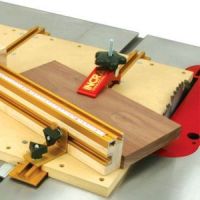More Tools Used in Woodworking / Woodcrafting
Whether you just want to make some furniture for your own house, or you want to start your own wood products factory, then there are some tools and equipment that will make the process faster, easier, more fun, and produce a better result. In previous articles I’ve discussed both hand tools and power tools for woodworking projects, and gave several examples, but I left out a few. To be honest, I could go on for days and not have an exhaustive list of the variety of woodworking tools and equipment available. So here are just a few more, used to shape a piece of wood or join two pieces of wood together:
Biscuit joiner: A biscuit joiner, also sometimes called a plate joiner, is used for creating a strong, stable joint between two pieces of wood. This is especially useful when two pieces of wood meet edge-to-edge, where the use of screws or nails wouldn’t really be possible. A small circular blade is used to cut a slot, called a mouth, into each piece of wood to be joined. A small “biscuit” of wood, kinda shaped like the silhouette of a football, is then glued into the slots where the two pieces of wood meet. The end result can be quite precise and sturdy.
Chainsaw: A chainsaw is a power tool, driven by electricity or gasoline, with its cutting teeth set in a chain that moves around the edge of a stationary blade. The typical woodworker doesn’t usually think of a chainsaw as a woodworking tool, but there are several woodcrafters who would beg to differ. If your woodworking project includes the use of whole logs or branches, you can collect some free wood for your projects by felling a tree (where you’re legally allowed to do so), and/or cutting limbs from a tree. There are even true artists who use a chainsaw as a carving tool to create some incredible statues or sculptures.
Drill: A drill is a rotary tool that spins a drill bit, used for making holes in wood (or metal or whatever). With various sizes of bits, making various sizes of holes, they can be used to create pilot holes for nails or screws, or for pins or dowels that may be glued into place.
Nail gun: Of course nails are one of the many choices for joining two pieces of wood, but if you have a lot of nailing to do, then using a hammer may get tedious and tiring. A nail gun uses power, be it from electricity, compressed air, propane, or butane, to drive a nail at the pull of a trigger. With many nails in a magazine, on a strip, or on a roll, the speed at which you can drive a lot of nails makes the nail gun a popular choice among carpenters, woodworkers, and woodcrafters. (Not to mention the fact that you don’t have to worry about hitting your thumb with a hammer!)
Router: A router is a power tool with spinning blade, or “bit”, set either downward from the center of a two-handed tool, or upward from a tool mounted under the middle of a table. With an endless variety of bits, it is used for several purposes including putting a decorative edge on wood, cutting out (or “routing out”) a section from the interior of a piece, forming tongue and groove edges for joinery, and so on.
Sander: To give a piece of wood a smooth finish, or to prepare it for staining or painting, there are a variety of options, from just a piece of sandpaper in your hand (offering the most control, but the most time consuming method), an emery board, sanding block, sanding sponge, or a wide array of powered options. A belt sander, whether handheld or benchtop, makes quick work of smoothing a surface, but can leave streaks if you’re not careful. To address that possibility, an orbital sander (sometimes called a random orbit sander, or ROS sander) moves a disk of sandpaper in short, quick, random directions across the surface. A sheet sander operates in a similar manner, but in a circular motion, and using a standard square or rectangular piece of sandpaper. A disk sander (or disc sander) simply spins a circular piece of sandpaper in a circle, which could leave circular streaks or semicircular gouges in a surface. A detail sander usually has a small triangular sanding pad, although other shapes are available, and vibrates that pad either in a circular or side-to-side motion, depending upon the model. A drum sander, usually mounted under a platform, spins a cylindrical sanding drum, especially handy for smoothing curved surfaces and edges. Finally, a lot of benchtop sanders combine several of these into one tool, like a disk sander, belt sander, and/or a drum sander all mounted on one base.
Rotary tool: For fine detail work, a rotary tool allows both power and control. There are a variety of rotary bits available for anything from cutting, grinding, sanding, carving, engraving, cleaning, polishing, and so on. The shear versatility of this tool makes it a must-have for almost any woodworker or woodcrafter.
Look for more articles coming soon with more detail and ideas on using these tools and many others!



